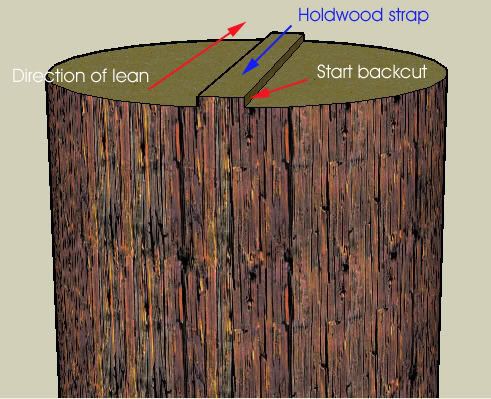Metals406
Granfodder Runningsaw
I'd still like to know if this is the cut being described... Or if I'm not sippin' what he's pourin'?




Well, I would expect any falling tree to pop the hinge and rock back over the stump. If there is any rotation or roll during the fall it is going to be erratic. I guess I was confused about the angle of the tree lean here. The low-side and high side in the diagram also throws me off. If he is trying to fall it directly with the lean, that makes it a lot simpler. I was thinking he was trying to fall it against the lean to some degree (to keep it from laying over one way or the other). I have used angled hinges and bore cuts to protect an area that I do not want a tree to fall in. Not perfect, but they tend to be good ways to get a tree into a specific area (I got the idea off of AS some years ago).
I would think that a bore cut strap would stop the fall the same as the 'arrow cut' though. Put in wedges on either side of the bored back cut and it would help prevent it from falling off-angle. I guess the arrow is just a fat strap.
Yeah, metals. That's what he's describing. As far as I can gather at least. That cut ( with a wedge in each side to help prevent unexpected twisting ) seems like it should pop the leaner right off the spar and straight down as opposed to having it try and lay out and coming back at you the way a hinge could do in that situation.
It's definitely an interesting technique.












Gerry Beranek isn't enough of a professional endorsement?
Is this cut for side lean trees or heavy leaners intending to fall in the same direction as the lean?
The "low side / high side" notation on either side of the hinge is throwin me off.
An "arrow" cut ( at least the one I am talking about ) is used in the tree when your saw is quick enough and the wood small enough to blast through the cut before the top has time to move one way or another. You cut straight through the wood at a 45 degree downward angle as fast as you can so that it makes a spike or "arrow" when it comes off.
the MAN.
i am thinking if its a heavy head its going brush first anyway right? we know he had no facecut put in (out of fear of pinch maybe?)
by taking the sides out he could cut the holding wood in a controlled backcut allowing the top to get set free without the barber showing up. keep in mind it locust. good strong wood.
i could be dead wrong but i dont think he was "fast cutting" it. the cut you are talking about blakes.
also i wouldnt put those wedgies in either i dont think. you cant cut the strap if the wedges are in the way.
murph where are you?
i gotta go get my book!